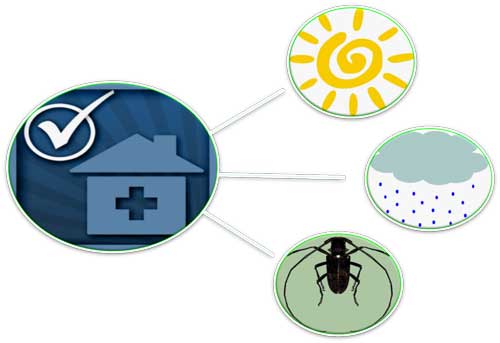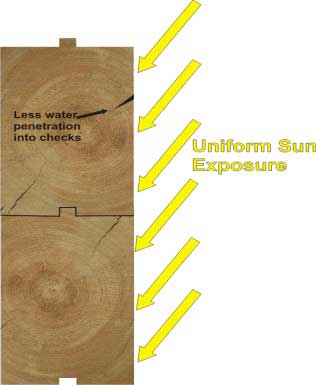Lighter colored stains that contain titanium white (KX) will also absorb less heat; therefore, there will be less overall stress (day surface temperature versus night surface temperature) that the finish system and wood substrate is exposed to over the course of a 24-hour period.
Squared logs, timbers, and vertical flat siding are easier to maintain since the sun hits these wood pieces at the same angle and the UV light is evenly distributed over the entire surface. In addition, the flat vertical surfaces cannot accumulate snow and ice and even upward facing checks are not as prone to rainwater entering the logs. Squared wood pieces are subject to the same weathering parameters as round surfaces, but the weathering is mostly uniform over the entire exposed surface.
The second challenging variable for wood in a coastal environment is moisture. Coastal areas are notorious for their high relative humidity and pop-up thunderstorms. Keeping wood dry is the goal to protecting its long term integrity. If wood remains wet for long periods of time without drying out, conditions are favorable for the formation of wood decay fungi, the precursor to wood rot. Four conditions are necessary for the development of wood decay producing fungi. Eliminate any one of these and decay fungi cannot survive: oxygen, temperature (40° - 90°F), moisture content in excess of the fiber saturation point (> 25-30%), and a suitable source of energy and nutrients (that is, the wood).
Recommendations:
- There are two basic ways to combat the effects of weathering. By far the most effective method is to keep wood surfaces in the shade as much as possible by extending roof overhangs or constructing roofed porches around the home.
- Keep all vegetation at least 24 inches away from wood surfaces to allow for adequate ventilation and drying out of these surfaces.
- Clean the wood surfaces to remove all foreign materials from the wood prior to the application of an exterior finish system. The overall performance of even the best finish system is dependent upon proper surface preparation and application technique.
- Select and apply a highly durable exterior semi-transparent stain, like Lifeline™ Ultra-7 or Ultra-2 to protect the wood and enjoy the beauty of the wood grain. Select Lifeline™ Accents to highlight wood timbers and trim if more opacity is desired.
- Select a color that contains shades of brown, red, or gray. Consider colors that contain titanium white (KX) for lower surface temperature swings as well as good UV protection. (colors: Butternut, Wheat, Driftwood, Stone Gray or Gentry Gray).
Ultra-2 standard colors:-
 Butternut 854
Butternut 854
Butternut 854
Butternut 854
-
 Autumn Gold 815
Autumn Gold 815
Autumn Gold 815
Autumn Gold 815
-
 Dark Honey 822
Dark Honey 822
Dark Honey 822
Dark Honey 822
-
 Oak 832
Oak 832
Oak 832
Oak 832
-
 Wheat 821
Wheat 821
Wheat 821
Wheat 821
-
 Natural 880
Natural 880
Natural 880
Natural 880
-
 Dark Natural 830
Dark Natural 830
Dark Natural 830
Dark Natural 830
-
 Sequoia 835
Sequoia 835
Sequoia 835
Sequoia 835
-
 Hazelnut 870
Hazelnut 870
Hazelnut 870
Hazelnut 870
-
 Cedar 885
Cedar 885
Cedar 885
Cedar 885
-
 Bronze 874
Bronze 874
Bronze 874
Bronze 874
-
 Chestnut 868
Chestnut 868
Chestnut 868
Chestnut 868
-
 Walnut 865
Walnut 865
Walnut 865
Walnut 865
-
 Driftwood 861
Driftwood 861
Driftwood 861
Driftwood 861
-
 Stone Gray 863
Stone Gray 863
Stone Gray 863
Stone Gray 863
-
 Gentry Gray 842
Gentry Gray 842
Gentry Gray 842
Gentry Gray 842
-
 Beachwood 848
Beachwood 848
Beachwood 848
Beachwood 848
-
 Barn Gray 872
Barn Gray 872
Barn Gray 872
Barn Gray 872
-
 Classic Brown 878
Classic Brown 878
Classic Brown 878
Classic Brown 878
-
 Pickled White 850
Pickled White 850
Pickled White 850
Pickled White 850
-
 Ebony 890
Ebony 890
Ebony 890
Ebony 890
View the embedded image gallery online at:
https://www.permachink.com/blog/wood-damage#sigProIdb85362f728 -
- Apply an exterior clear topcoat, like Lifeline™ Advance Gloss or Satin, to protect the color coat and add additional UV and mold and mildew protection. Consider the Gloss for additional reflection of UV light.
- Fill all upward facing checks, cracks in wood, with a specialized acrylic sealant, like Check Mate 2™
- Clean the finish systems at least once a year with Log Wash™, a liquid concentrate for bare wood and maintenance cleaning, to remove all foreign debris for the surface of the finish system and extend its longevity.
- Perform an annual inspection of the coating system as a proactive maintenance approach.
- Darkening of the wood or finish when water is applied, is an indication of water getting through the coating and wetting the wood
- Checks or micro-fissures in the wood, especially upward-facing
- Cracks in the finish
- Color fading
- Pay close attention to the south- and west-facing surfaces
- Keep metal surface clean and freshly painted. Salt spray is highly corrosive.
|
You can't completely stop or reverse the weathering of exterior wood, but you can slow the process dramatically by using the right type of finish system and a proactive game plan to combat the environmental elements. |
 |


 Sunlight is the major cause of damage to a number of materials, including plastics, textile, wood, coatings, and other organic materials. The type of damage, such as loss of gloss, chalking, elasticity, adhesion, and color change, varies depending on the material sensitivity and the spectrum of sunlight. Spectral sensitivity varies from material to material.
Sunlight is the major cause of damage to a number of materials, including plastics, textile, wood, coatings, and other organic materials. The type of damage, such as loss of gloss, chalking, elasticity, adhesion, and color change, varies depending on the material sensitivity and the spectrum of sunlight. Spectral sensitivity varies from material to material.